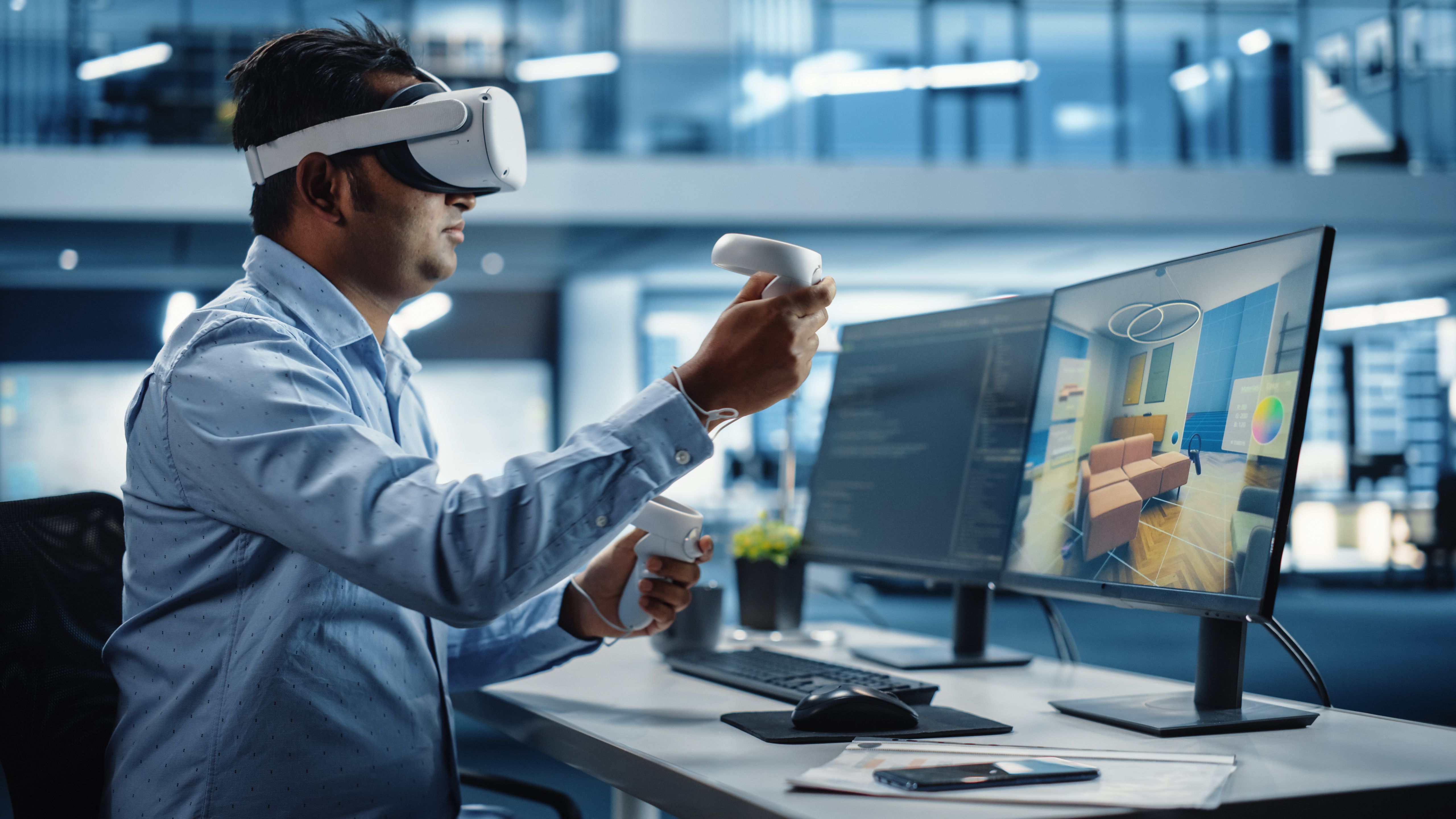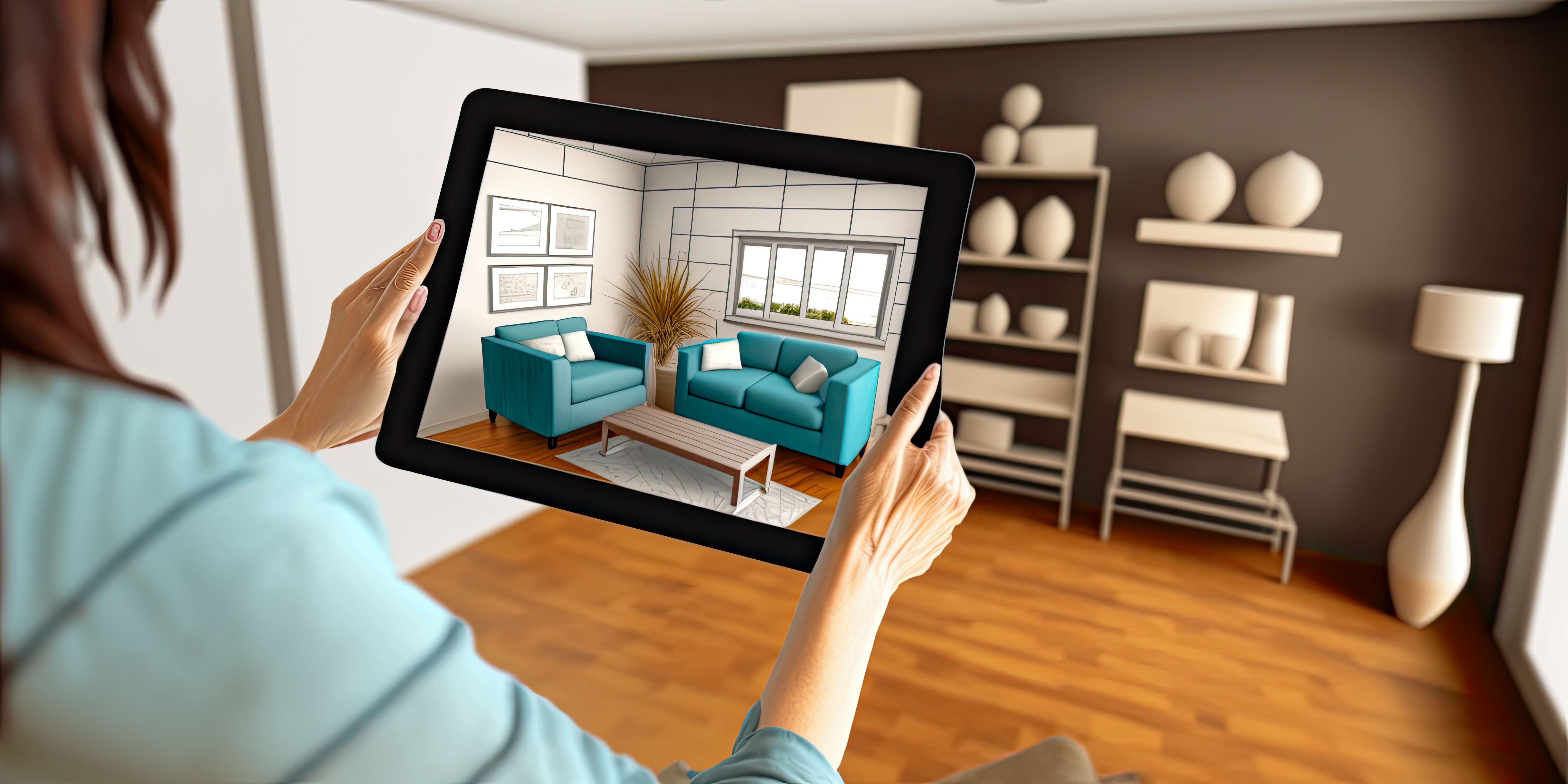Virtual reality (VR) has brought about a revolutionary shift in our perceptions of the world, impacting an array of industries, from eCommerce to fashion and retail. Among them, interior design is one industry significantly influenced by VR technology. In this blog post, we’ll explore virtual reality's impact on interior design. We’ll discuss its benefits for this industry and the challenges faced by interior designers when using virtual reality technologies.
Reimagining Spaces with VR and Interior Design
Virtual reality is transforming interior design, offering a new way to visualize and experience home projects. With VR, interior designers can create a full visual presentation of a home in any style or design, allowing customers to make better decisions about their purchases and renovations.
Let's explore how VR is impacting the field of interior design.
Tailored Home Presentations for Clients
VR technology allows interior designers to present homes in an immersive 3D environment, giving customers the opportunity to explore the space from all angles. This helps customers better understand how their home will look after the project is completed.
For example, a customer could use VR to walk through their new living room and see how different furniture arrangements would look. They could also see how the room would look with unique lighting and color schemes.
Virtual Preview: Furniture and Accessory Shopping
VR also makes it easier for customers to preview furniture and accessory purchases before they commit to buying them. Customers can also virtually place furniture in their homes and see how they look with existing décor. For instance, as a customer, you can use VR to see how a new sofa would look in your living room before you actually buy it.
Design Dream Spaces: Testing Colors and Redesigns
With VR, customers can also test out color changes or major redesigns without committing to them immediately. This enables customers to preview changes beforehand and helps them save both time and money by avoiding design errors.
Finding Your Way Around
By utilizing VR technologies, customers can learn more about their new home’s location before making any major changes or purchases. Customers can explore nearby attractions, amenities, schools, and parks, ensuring they are making the right decision for themselves and their families.
Virtual reality can potentially revolutionize how prospective homeowners search for their new abode. Customers can experience the look and feel of various properties by immersing themselves in a virtual tour. This scenario serves as a testament to the exceptional potential of VR technology.
Space, Light, and Compatibility: Harmonizing Spaces
VR technology makes it easier for interior designers to calculate space requirements, light levels, compatibility with existing décor, and more when designing a room or home project. This helps ensure that all elements come together seamlessly for a successful outcome.
An interior designer can leverage Vection Technologies’ Mindesk to place and visualize every aspect of a kitchen space virtually. They can experiment with different layouts, color schemes, and design elements that best suit their clients' preferences.
With virtual reality, they can get a realistic view of the project before it is implemented. This ultimately leads to a more efficient design process.
4 Benefits of Virtual Reality in Interior Design
Virtual reality has transformed the interior design profession, enhancing home, furniture, accessories, and color scheme presentations. It has also allowed for assessing redesigns and learning about the client's environment. This is key for marketing and sales in the interior design industry.
But what are the benefits of VR applications to interior design? Let’s take a look at these advantages.
Better and Clearer Presentations
With VR, designers have the ability to create more detailed and immersive presentations. By providing clients with a true-to-life 3D experience, designers are better able to convey their vision for a space, which ultimately helps clients make informed decisions with greater confidence.
This makes it easier for interior designers to collaborate with clients and bring their ideas to life.
Better Design Visualization
Virtual reality allows interior designers to engage with their environment like never before. With VR, interior designers can explore and modify their projects in real time, giving them the freedom to change finishings, furniture, and color schemes without physically measuring the space.
Interior design visualization via VR fosters greater creative freedom and innovation. Designers can now experiment with original concepts and ideas without fear of making mistakes.
Errors, Time, and Cost Reduction
VR can reduce human errors, time, and resources, and enhance collaboration among interior designers. By using virtual simulations of interior designs, designers are able to spot potential issues before building the physical product.
Avoiding costly corrections after construction starts helps save time and resources. Also, by sharing 3D models over the cloud with collaborators in different locations at any given time, teams can work together even if they are geographically dispersed.
Faster Decision-Making Processes
Virtual reality (VR) can facilitate faster decision-making processes for designers and customers alike, by providing instant experiential feedback. The technology enables customers to interact with products and experiences, resulting in better purchase decisions.
For designers, VR enables the quick and accurate creation of virtual prototypes, expediting testing and experimentation, which in turn can lead to more efficient decision-making and potentially better results.
Facing Challenges with VR and Interior Design
Virtual reality has become a powerful tool for interior designers, providing immersive experiences for clients. However, the widespread adoption of VR in the industry still faces some obstacles that need addressing. Let's take a closer look at these challenges.
VR Can Be Expensive
Creating a lifelike virtual environment requires both hardware and software components, which, unfortunately, can be quite costly. While many designers aspire to produce these types of environments, not all have the resources to do so.
This deficit can create a barrier to entry into the realm of cutting-edge design. Nevertheless, as virtual reality technologies become more refined, the hope is they will become more inclusive and accessible to more individuals.
Hardware Limitations
Hardware limitations are challenges for interior designers intending to introduce VR in their projects because it can be difficult and costly to acquire the specialized equipment needed to make VR experiences accessible for clients.
Furthermore, the technology is still relatively new and there may not be enough experienced personnel who are able to work with the hardware, which can limit the range of services an interior design firm can offer.
Additionally, there may not be enough software available yet that can be used to create detailed virtual environments that accurately reflect a designer’s vision. This could lead to frustration as designers try to find ways around these limitations in order to produce the desired results.
Creativity is Hindered by Software Limitations
Creating realistic virtual environments can pose a challenge due to software limitations. Many of the current software packages lack features such as lighting effects or textures that are necessary for designers to create authentic and lifelike experiences. This makes it difficult to mimic the complexity of real-world scenarios and environments in virtual spaces.
Despite this, advancements in software and hardware continue to create more powerful and realistic design tools that are helping to close the gap between the virtual and physical worlds. For instance, Vection Technologies’ 3DFrame and Mindesk allow interior designers to add materials, textures, and colors to designs.
Technical Expertise Is Also an Issue
Creating a realistic virtual environment requires a certain level of knowledge and experience that not all designers may possess. Without this technical expertise, they may miss out on the full potential of VR technologies and their application in their work.
In the interior design world, it's becoming increasingly important to stay current on the latest tools and techniques to remain competitive and provide the best possible results for clients. Companies need to help designers to hone their skills in virtual reality, so they can unlock new projects that engage customers.
Client Acceptance Is a Major Challenge
Although virtual reality has become an integral part of interior design, some clients remain hesitant to try it out. Some may feel susceptible to motion sickness, while others may face budget restrictions and therefore feel that a VR experience isn't feasible. There are also clients who simply lack knowledge about virtual reality and how it can enhance their homes.
Staff Reluctance to Use VR
Due to the unfamiliarity of using new technology or difficulties associated with the learning process, some staff members may be hesitant to embrace such change. Especially when these technological advancements aim to streamline and improve their workflows.
However, keeping an open mind towards this change is essential as it can lead to higher productivity and better outcomes in the long run. With patience and guidance, staff members can be trained to make effective use of this new technology, leading to a more efficient and smooth transition over time.
What is the Future of VR in Interior Design?
The potential of virtual reality as a valuable tool for interior designers is truly significant. By accurately simulating real-world scenarios and enabling seamless remote collaboration, VR has the capacity to transform interior design practices fundamentally.
Its impact goes beyond aesthetics alone, offering substantial benefits in terms of time, cost, and resource savings. Moreover, VR's accessibility empowers consumers from diverse backgrounds to actively participate in the design process and make faster purchasing decisions.
Virtual reality is poised to play a crucial role in shaping the future of interior design, establishing itself as an essential force in the industry.

